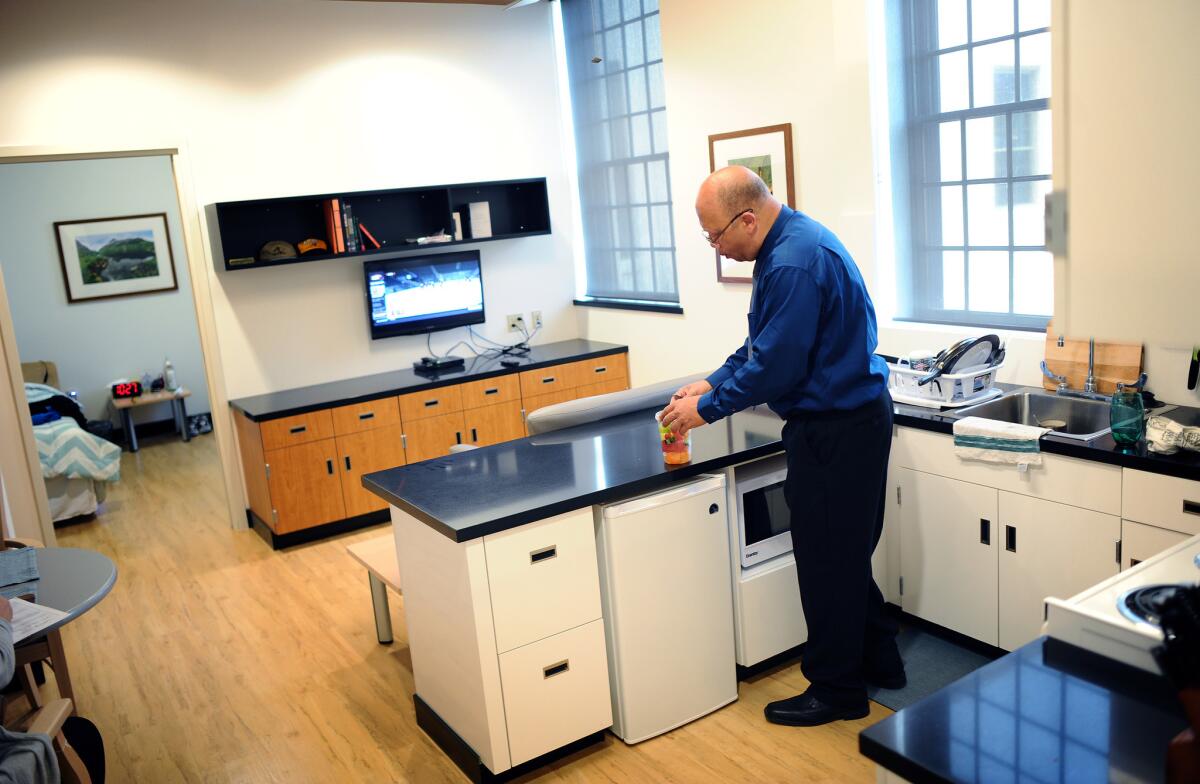VA unveils housing for 65 homeless veterans

Veteran Keith Hudson opens a jar of fruit inside his home in the newly refurbished supportive housing at the Los Angeles VA campus.
- Share via
The smile never left Keith Hudson’s face, even when he spoke of his divorce and his descent into alcoholism and homelessness. In his blue dress shirt, tie and slacks, he could have passed for the paralegal that he once was and hopes to be again.
Hudson, 52, now has a home, a job and a future — all because of an effort launched more than a decade ago to convert an underused building on the West Los Angeles Veterans Affairs campus into residences for chronically homeless veterans in need of medical or mental health treatment.
“When I walked into this building,” the Army veteran said, “it was like one of those movies when you walk through a cloud and you’re like: ‘Whoa! Wow!’ Everything was state of the art, brand new. It’s like an apartment complex and a five-star hotel combined into one, with all the amenities.”
After years of debate, inaction, funding delays and a high-profile lawsuit filed on behalf of veterans, Building 209 — the newest housing for veterans on the campus — finally had its unveiling last week.
It features a soaring atrium entrance, a fitness room, a large kitchen where vets can learn culinary skills, communal sitting areas, Wi-Fi and 55 single- and double-occupancy units that will house a total of 65 veterans. A few units on the upper floor have ocean views. Twenty women will live in a secure wing with an exit to a “serenity garden.”
Leo A. Daly, a noted architectural firm, designed the $20-million renovation and seismic upgrade of the 51,000-square-foot building, one of many on the campus that the federal government has deemed historic. The work took about two years.
Outside, stairways and ramps lead through a nascent garden to the entrance. The three-story building, which had long sat nearly empty, stands in stark contrast to much of the rest of the largely neglected campus.
Hudson’s furnished one-bedroom apartment comes with a TV, a living room and a kitchen, where the amateur chef intends to spend much of his time perfecting recipes taught him by his Chinese, Cherokee and African American relatives.
Los Angeles County has long had the largest concentration of homeless veterans in the country — more than 4,300 in the latest count. Two-thirds of them live in the city.
Hudson routinely slept on benches in the western San Fernando Valley, counting on his martial arts skills to fend off danger. About a year ago, he entered a rehabilitation program at the VA and lived in a domiciliary with five roommates.
U.S. Department of Veterans Affairs Secretary Robert A. McDonald, who attended the opening, said that after starting his job in July, he looked into the 2011 lawsuit filed by the American Civil Liberties Union and Public Counsel against the West Los Angeles VA. The suit alleged that the VA was failing to live up to its obligation to use the land to provide housing.
While serving as a Santa Monica city councilman, Bobby Shriver helped propel the litigation. McDonald, the retired chief executive of Procter & Gamble, and Shriver’s brother Tim are friends, and McDonald said the family connection contributed to his interest.
“It didn’t make sense,” McDonald said of the lawsuit. “We were being sued for not caring for veterans, which is our mission.”
McDonald sat the two sides down and in January announced a legal settlement under which the VA agreed to transform the sprawling campus into a center of permanent housing for homeless veterans and to curtail the controversial practice of leasing VA facilities to corporations and other non-government entities.
The opening of Building 209 marked a tangible step forward, he said. Veterans staying at the facility will receive job training and supportive services, with the goal of moving into permanent housing elsewhere. And they will be paid for the work they do. Hudson, for example, is a housekeeper in the VA hospital on the campus.
Two nearby buildings — 205 and 208 — are also to become transitional housing.
“Have we solved the problem of homelessness in Los Angeles? No,” McDonald said. “Are we making progress? Yes.”
Local and federal officials have made a commitment to ending veterans’ homelessness in the county by the end of the year as part of a national goal led by the Obama administration.
On Friday, McDonald, Mayor Eric Garcetti and the United Way of Greater Los Angeles kicked off an effort to identify 1,000 new units this year for veterans in need of housing. In a statement, they said a commitment from market-rate landlords willing to accept veterans with housing vouchers would be the “critical last step” to housing veterans who are already on the streets and others who will become homeless.
More than a decade ago, Shriver helped lead the push to earmark Building 209 and two other underused structures on the campus for housing. At the time, he thought the transformation would be easy, but it took years to get just one up and running.
In a posting on Facebook, Shriver said he was thrilled to see the results but added that he felt sad and angry — “sad for all the vets who needed this housing over the decades that the building stood vacant.… Angry because political leaders had the power to make this happen decades ago!”
As Hudson surveyed his spacious, clean quarters, it was clear that sadness and anger had been replaced by relief and joy — and the possibility that he might soon return to the paralegal work he enjoyed in years past. “It feels so good,” he said.
Twitter: @MarthaGroves
More to Read
Sign up for Essential California
The most important California stories and recommendations in your inbox every morning.
You may occasionally receive promotional content from the Los Angeles Times.











